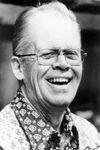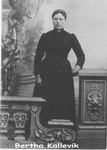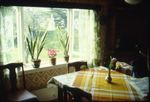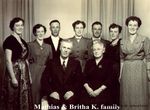INTRODUCTION
This history of the Kalevik – Kallevik - Kallevig goes back to some of the relatives in Norway, but mostly of all the relatives in America up through 1987. It took two years to gather the information and pictures and to write and compose the book.
There are three editors - Erwin Kalevik, Marion Rime, and Harold Kallevig - each doing one branch of the relatives. Harold also did most of the research from Norway. The typing was by Earl Leaf of New London and Marion Rime of Spicer.

ERWIN KALEVIK

ERWIN KALEVIK
Erwin Kalevik is the editor of this first section, the
Ole Kalevik Branch. Ole was Erwin's grandfather.Added 10/1/1999 by Loren Kallevig
Harold Kallevig is the editor of the second section, the
Elias Kallevig Branch. Elias was Harold's grandfather.Marion Rime is the editor of the third section, the
Johannes Kallevig Branch. Johannes was Marion's grandfather.The Kalevik- Kallevig Family History 1755 – 1987 has no discussion of Helene Johanne Mathiasdtr Kallevig who apparently came to America together with Ole Kalevik. However, one of her descendents has a web page that may be of interest.
Helene Johanne Mathiasdtr Kallevig Branch.Now just a little bit about Erv, as we call him. He was born 19 Nov. 1922 on a farm in Green Lake Township, Section 21, and has lived in the same general area all his life.
Erv is the author of several other history books - HISTORY OF NEW LONDON, MN; HISTORY OF GAUSDAL CHURCH, GEORGEVILLE; KALLEVIG REUNION BOOK 1978; and co-editor with his daughter Jean of HISTORY OF GEORGEVILLE, MN.
He writes a historical article, "Out of the Attic," for the New London - Spicer Times each week. He is one of the founders and president of the Monongalia Historical Society in New London. For 32 years he was in business in New London as owner of Erv’s Radio and TV Sales & Service. He is now retired.
His pride and joy is his family and home, which you will read about, in this section of the book.
The editors of this book dedicate this history in honor of all of our forefathers, those who have gone on before us.
OUR ROOTS
The roots of the Kalevik - Kallevig families are in Norway, centered pretty much in the area of Mosterhaven near Haugesund.
The records we have of earlier years in Norway are through research done by Harold Kallevig and also some from the history book from Norway called Bømlo Bygdebok.
The first records found were in 1755, those of Endre Danielson, who was married to Anna Larsdatter. They were great great grandparents of our forefathers in America, Johannes, Elias, and Ole Kalevik.
In the next generation down, the son of Endre and Anna Danielson was Lars Endreesen Danielson, born in 1712, and who died in 1800. He was married 27 October 1765 to Mari Jacobsdatter Stokke.
In the third generation, Lars and Mari's son Jakob Larsen Kalevik was born in 1769 and died in 1842. His first wife was Synneva Halvardatter. We don't know when she died. His second wife was Mari Olesdatter Vestvik, born in 1773. She was the daughter of Ole Anderson Westwig, who was born in 1716 and who was married on 30 June 1770 to Marie Jochumsdatter Waage, born in 1742.
Jacob Larsen Kalevik had six children: Halvard (1805), Sissela (1806), Mathias Jakobson Kallevik (1811), Lars (1814), Johannes (1819), and Ingeborg (1822).
As far as we know the old Kalevik homestead was the first farm that was cleared of woods and brush in that area. This place was called Kalevik because translated it means "Calf Bay," and it was used as a calf pasture in the early days. As far as we know, Jakob Larsen Kallevik 's was the first family to live here. They rented the farm in 1825, and in 1835 they owned the farm. Both Jakob and his wife were veterinarians in the District.
In the fourth generation Jakob's son Mathias Jakobson Kallevik was born in 1811 and died in 1892. His first wife was Kari Olsdatter Baatvik, born in 1805 and died 1847.
To this union four children were born: Ole (1832), Jakob (1833), Johannes (1841), and Lars (1844). Three years after their last child was born Mathias' wife Kari died.
In 1847 Mathias was married to Johanne Johnnesdatter Kin, who was born in 1822 and died in 1884. This was Mathias Jakobson Kallevik's second marriage; and Mathias and Johanne were the parents of our forefathers here in America - Johannes, Elias and Ole. Some of the children from Mathias' first marriage had the same names as some of the children of the second marriage.
The children from the second marriage were Johannes (1849), Ragnhild (1850), Katla (1851), Synneva (1852), Aagota (1854), Kristianne (1855), Elias (1857), Mathias (1859), Helga (1862-1862), Helene (1863), and Ole (1866).
Mathias and Johanne Kallevik became owners of the Kalevik homestead in 1828 but had rented the property a few years before that. In 1864 they owned four cows, three calves, seventeen goats, and raised one Norwegian ton of oats and three tons of potatoes. Mathias and his wife were also amateur veterinarians.
Four of their sons came to America - Johannes, Elias,
Ole and Mathias. But Mathias returned to Norway.Just a little about Mathias. He came to America in about 1888. He and Ole farmed in partnership from about 1894 to 1899. The farm was located in Arctander Township, Section 15. But Mathias decided to move back to Norway to live. Mathias and Ole sold the farm and dissolved the partnership.



MATHIAS AND BERTHA MATHIASON KALLEVIK Source: Helga Marie Kallevik, granddaughter of Mathias

MATHIAS AND HIS 5 OLDEST CHILDREN Source: Helga Marie Kallevik, granddaughter of Mathias


THE HOUSE ON THE KALLEVIK HOMESTEAD IN NORWAY



INTERIOR OF THE HOUSE May 6, 1978
Mathias was born in 1859 and died in 1925. He was married to Berta Oline Reidarsdatter. She was born in 1873 and died in 1908, the same year as her last child was born. They had seven children: Mathias (1899), Anna (1900), Reidar (1902), Jacob (1903), Lars (1905), Berta (1908) and Johanne (1908).
The next generation down in Norway was their oldest son, whose name was Mathias Mathiason Kallevik. He was born in 1899 and was the next to take over the Kallevik homestead. He was first cousin of the children of Johannes, Elias and Ole in America.

MATHIAS AND BRITHA K. FAMILY. Standing: Ruth, Bertha, Mathias, Solveig, Johannes, Anny and Mary
Seated: Mathias and Britha Source: Helga Marie Kallevik, daughter of Mathias

MATHIAS AND BRITHA KALLEVIK

MATHIAS, BRITHA, JOHANNES KALLEVIK
May 6, 1978
BRITHA, MATHIAS, JOHANNES, MATHIAS
Mathias was united in marriage to a girl from Haugesund by the name of Brita Marie Jakobsdatter. She was born in 1896. They had seven children: Mathias (1923), Birger Johannes (1925), Solveig (1926), Berta (1928), Anny (1930), Ruth (1931), and Britha Mary (1935).
Mathias died in 1987 at the age of 91 and Britha died later the same year.

Photo: Jens Kristian Ellingsen, April 2nd. 1999
THE KALLEVIK HOMESTEAD IN NORWAY
BACKGROUND
Just a little about this area where the Kaleviks and Kallevigs settled - Kandiyohi County, Minnesota.
This area was not settled until the 1850's. Before this time in history there were a lot of territorial changes before things really settled down, because of political divisions in the early days.
Our part of Minnesota, west of the Mississippi was a colony of Spain. The Spaniards exercised a nominal sovereignty until the beginning of the 1800's, at which time, by treaty stipulation, the area was transferred to France. On 2 December 1803 France officially transferred this territory to the United States of America.
From that time until 1858 the boundaries changed. Our area was at one time a part of the Louisiana Purchase. It was later included in the Territories of Upper Louisiana, Michigan and Iowa; and the boundary lines of the counties changed several times also.
Until 1856, when the government surveyed this area, there was very little activity here by the white man. It is interesting to note that if the white man had settled here in 1800 and would have lived here for 60 years, he sure would have had a lot of address changes through those years. He would have lived successively under the sovereignty of Spain, France and the United States, and would have been a citizen of the Territories of Upper Louisiana, Michigan, Iowa and Minnesota. He would have been under the jurisdiction of the counties of Dakota, Pierce, Renville, Stearns, Monongalia and finally Kandiyohi
From 1858 to 1870 the north half of what is now Kandiyohi County was Monongalia County, and New London was the county seat. But in 1870 Kandiyohi and Monongalia merged and made one county the size that it is today. The name Kandiyohi was chosen, and Willmar became the county seat.
After this area had been surveyed in 1856, people could come into the area and take homestead. All they had to do was stake out a claim of their choice and have it surveyed; and after they had lived on it for a certain length of time, the land was of officially theirs. People from Europe immigrated to America by the thousands to take homestead and make a home for themselves here.
The Kalevik - Kallevig families didn't come to America until in the 1880's. By that time the homestead land had been taken. So they had to purchase their farms, but land prices were quite reasonable at that time.
Many farmers who lived on quite large farms needed hired help, which was hard to get in those days. So the wives also worked hard on the farms. Many of the farmers would write to Norway to get people to come over here as hired hands -- men or women. The farmer would pay for their ticket to get from Norway to here; then they would work for the farmer for little or nothing in w ages until the debt was paid off, after which time regular wages would be paid.
This is how our grandmother,
Anna Emberland, came to America. There was a family living south of Belgrade by the name of Mads Johnson. The Johnsons were parents of well-known Henry M. Johnson, funeral director at New London for many years. The Johnson family needed a hired girl, so they wrote to their family in Norway and asked if they knew a nice girl who was a good worker and would like to come to America to work.Yes, they knew a girl by the name e of Anna Emberland, who had also worked for them and had mentioned that she would like to go to America. So the Mads Johnson family wrote her a letter, to which she replied that she was interested. So they paid for her voyage to America.

